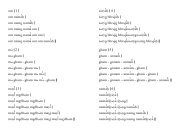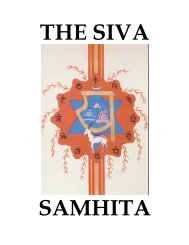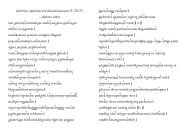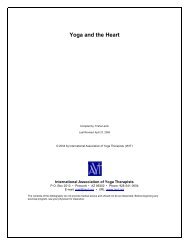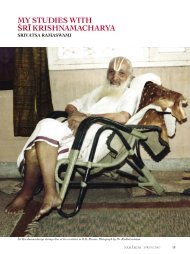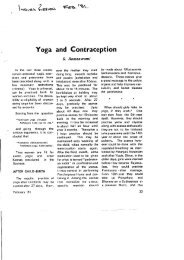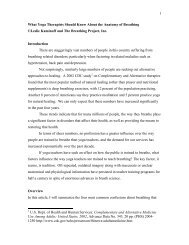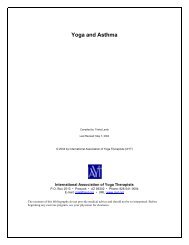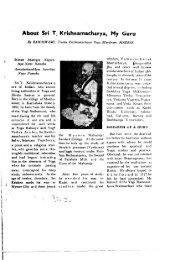Download PDF - Centre for Yoga Studies
Download PDF - Centre for Yoga Studies
Download PDF - Centre for Yoga Studies
Create successful ePaper yourself
Turn your PDF publications into a flip-book with our unique Google optimized e-Paper software.
On Antharanga SadhanaBy S. RamaswamiIn the pravious issuas many groups of<strong>Yoga</strong>sanas and Pranayamas have beenoxplained and bsnefits indicated. Whilethese practices-according to Hathayoga-givemany physical and physiological benetits,Patanjali would urge the aspirants to gobayond and work towatds the taans<strong>for</strong>mationof the mind (chittaparinama) itself. Thispractice known as AntharangaSadhana helps atqualitative and permanentchanges in rho chitta bymeans of practice; th€s€increase and strengthen thehabits (samskaras) of nirodha,samadhi, and ekagratha.successively to theexclusion of rhe distracrd(vyuthitha) semskaras.GO FURTHEBPranayama helps to reducethe painful and disttactingtendencies of chitta whsnit tends to bocome predominantlysathwic. Sueh amind also becomes capablsof concentrating and holdingon lo subtle obiocta.Many of us stop with as!-nas and Pranayama. Whilethose by thomselves give rise(to many benefits as a hoalthy frame, sufficiontmental clarity to cary on tha day to daywork. - the psychological experiences andultimat€ spiritual experience require furtherrigorous practice. Since wg normally goback to tho normal way of lifs after the twoaspects of sadhana, the sensaS continue todistract tho mind. Altornating botween
yogabhyasa of th€ rudimentary kind and antaranga sadhana. The thr€e parts, viz.sensual activities. wo wonder about the r€al Dharana, dhyana and samadhi are only diffeefficaciesof <strong>Yoga</strong>sadhana.tent discernable stages each succeeding theOtner.Pratyahara, the tifrh anga of yoga is tohelp prevent this slide back. Antogonist to In tha first chapter of Patanjala yoga,furtheryogabhyasaistheindulgencethrough sarnadhi in its various ramifications arethe ssnsual objects which lead again to detailed. In the second, ths prefequisitopassion and dolusion. Having practised practises td mak€ the mind fit <strong>for</strong> Dharanavama, niyama. asana and pranayama to are dgscribod. In the third chaptet to creatoachievo mental clarity, the indriyas'influence intarest and also <strong>for</strong> thoso so inclined,on tho mind greatly reduces. When that cattain siddhis are describEd and tho mornshappons, there is a bettor awareness of th6 of such lttainments,spotless satwic rspect of chitta and thoindriyas also becoma satwic. Henco they, Going back to tho question of whatas it were, mergo with tho chitta 5r1*r. should be the obiect <strong>for</strong> contemplation, th€That is, as the chirta is given orher subtle; Rshl is delightfully vaguo in this, mainly toTatwas, the indfiyss do not cause any int€r- accomodate the vatious classgs of antarangaference.abhyasis . whother ho be a devotee, religious*HANM'KHT MUDBA HErpsff:'::'JJ"1',".1,3":il"'il:tlf;"::T:;:Ptalyahata, some pgople aver, is ansomo specitic guiclelines'offoct of Asana and Pranayama, rhile someEven though by means of the yama tosay it is also a specific practico. Shanmuth.i- pratyahara, tho basie dafilement of restlessmudra.a simpla exercise menti.oned .i" ;;;.';;;" chitta is grearty reduced, sincsFebruaty 1978 issue helps strengthen. lh" tt" chitta is basically wandering andPratyahara habit. But a fundam-ental,de"irion unsteady (Manaschanchalam Asthtramr,about what object ot Tattwa sholld be conwittrout'conjoiningwith an obiect, it doost€mplated upon by ths now satwic_free not ur"or" steady and hence the need <strong>for</strong>chitts' should be made Here rle1e, tt"-tt.rpport of an objact (Aasraya).many views ag there are schools. For "instance Hathsyogis refer to nadanusa.nilgna SUBHASHRA'Aor listening to the Anahata (th!t which lire- ---""-'rally meens that sound produced without But we havo excludod' by means ofrubbing of two objects) made possiblo 6y Bahitangasadhana those contacts whichShanmukhimudra and this should be Produce painful bondage. lt is now necssstt€mptod.sary to find the support (ashraya) of thatrhe rhird chaprer or paranjara ,"n",' llliltttiiffi';:^::::]:rt:"liir?r:i'::devoted exclusively to describe th€ t€ch- bondage, would progressively lead thenique of concentrstion, th€ tatwas to be s66y631 to Kaivalya (thsre ar6 very manyconcentratod and the benefits or siddhis that nsmg6 given to this ultimate state of chitta).sccrue to the abhyasi.through stages of superior enlightenment,The technique itself consists of thteestagos, but put as one is called y1gSuch an object is tormod as subhasraya.lt the mind, contacling an object, by whichl!
does not sutfer restlessn€ss and subsequ€ntbondage (Bandha), rhat object or support isknown as subhasraya. This subhasraya isof two kinds. Bahya and Aantara.It has been the practice to start withBabya dharana. To focus the mind on thecharming Murti of the Lord, made of panchalohaand as per the Agamas <strong>for</strong>tified by themantra is Bahya dharana. However, whens davotee by fepeated pfact;ce has thechittavirthi of the enchanting <strong>for</strong>m of theLord, even without the aid of the vigraha,thsn it bocomes Antardharana. Bhakti isnot merely unrestrained emotion of Love,but the channelising the chitta lowards thedivya <strong>for</strong>m of Lord so that the Bhakta has italways in his chitta to the exclusion of allorher thoughts or Vrithis.OTHER KINDS OF DHARANAThe yogis, however, suggest othetkinds of Anthardharana which will be helpfulequally to Bhaktas, gnanis. dharmis sndBairagis. To focus attention, as taught by IlearnEd preceptors, on such 'centres in thaBody as naval (Nabhi chakra), heart regron(htidaya pundarika) sahasrara, nasagra.jihvaagra, Bhrumadhya is also antharaThe difference betwe€n dherana, dhyanoand samadhi are subtle, but have howov€rbeen described in yogic texts and slso thoPuranas. When tho chitta having taken to sSubha object, continues to remain submorgedin the vrithi without a switch to another,that state of the mind is called dhyana vrithi.Even though dharana is also a chittavrithl on one object, there is considerableef<strong>for</strong>t in warding off other intruding objectivevrithis. In dhyana, without of<strong>for</strong>t ths mindstays withl.ha obj€ct, €ftortl6ssly, Accordingro Vishnu Purana:Tsdrupe Prstysyaikasgro Ssntati3chs Aryr nisspunhaTad dhysnaihi Prarhamsirang€ihi Shadbhiht ilishpad.However in dhyana, the distinctionbetween th€ meditator (dhyata) 8nd th€object of m€ditation (dhyeyam) remains.In Samadhi, or moro spocitically thesampragnata or sabija samadhi. when thedistinction between the dhyata and dhyeysvanish and only the object shines in its fullglory, then it is samadhi. Tho technical telmused by yogis <strong>for</strong> antaranga sadhana issamvama.CAN BE CHANGED BY PRACTICEdharana, which when developed to dhyanaand samadhi leads to vanous siddhis.One more pertinent observation may bemade. The Antaranga sadhana producesPraanaayamena Pavanamits own changes in the chitta, it is said chittaPratyaahaarena cha Indriyamis but the remainder of previous ssmskarasVasikfitya Tatah kuryaathfsamskara sesham hi chittam); thus powerfulsamskara replace weak samskara (Ptabal-Tatstaanam Subhaasrave.Having brought under control the nsurological<strong>for</strong>ces by Praanaayama, the sensesena durbalasya Badaha), which observationis common knowledge.by Pratyaahaara, one should resort to contempla:ionon a peacefulprinciple <strong>for</strong> mental Due to r€peatodsensual experiencesstability. According to Vishnupuranam, our chitta hss. ths samskaras of outgoingAntaradharana is frrmly fixing the enchanting (vikshipta). Due to vasanas of them people<strong>for</strong>m of the t-ord ffi?i6"s mind and this practiceof dharana should be done until dhyanarepeatedly go <strong>for</strong> such experienc6s. Furth€ra strengthening such samskaras also takestakes place. Srimad Bhagavatarm and many place by repeaied indulgenco- But it isother Puranas also detail this pfactrce. pc'-'srt:!e tc change it by practice, which is
fri.dgtailgd in the sciense of yoga. The Antar- persons who are respectivgly contenlgd, suf- - .;.anga sadhana produces mutationsinthebrair. tering, righteous, and unlawful-to ths exrent o "TheVyuthithachittatull of outgoing sams' of samyama-oneacquiresenormousmsl!9!;iUkaras is replacod by nirodha samskara, strength. And samyama on the principlewhich is to rafuse to respond to external of light known as jvotishmati vrithi, lhe i ,/stimuli. Then the samyama produces a lange of visi6n incteasos lo long distances ' "samadhi patinama or ths mental trans<strong>for</strong>ma' and line objects.tion to remsin in on€ object, to the exclusionof all other chittavrithis includrng the leeling By samyama on the sun, knowledge of |.) l.o._separar€ individnal identity. When thrs universe dawns. On chandra, if one.doesfconfinued, rhe chitta becomes complstely yogic sadhana, knowledge of the galaxies d-i".,Jtrana<strong>for</strong>medtobeing with one vrithi only becomeknown' The polar stat' samYama -1?frfri|fr-_G.-Et ugrata -parinama. When such o.n which provtdes the k€y fot the motion of 'chitta parinami takes placo, just as it is the stars and the galaxies'dirricutr to make the urrtn'j,ni;:"*il,:1]ff INTERNAL slDDHtschiila to even slsrt on yoga, when lnls llnal.tr'.r 'sabija samadhi is achieved, the chitta trans' Nearer home, within on€self. by samy- {$"'tormation becomss socomplete it is equally ama on naval region (Nabhichakra) one gots)n\difficult to make such a concentrating mind to know about one's anatomy (kayavyuha).to be disturbed. The Upanisads, puranas, Concentration on the insids of the throatsmirti eulogize such states. lt is lhe conten- (near the glottis) leads to control of thg : .-tion of yoga, that such stages are possible physiological functions, thilst and hunger. ' "and ars mechanical processes attainable by A nadi called Kurma is identified as the.1 1right practice and by ptactice alone'bronchial area. Concentrating on that, stea. ' 'i'ANTARDHARANAT'mind (breath) accrues' Bv samv-:::t-1tfama on Brahmarandhra, one communicates ]-3-,r!Vyasa commentarv on Patanjala yoga with siddhapurushas.relors to a nnqbgl of places or objects <strong>for</strong>such samyama, each one leading to its ownPRAATIBHAsiddhis and supetnormal powers and possession,Ev€ry chitta has the capacity <strong>for</strong> such ledge. All have it but in some it is rnoroThen certain people have intuitive know. 3?transtormation, and such accomplishments, manifest and frequently so. lt is called Praa.tibha, which is indicative. By concentratingIt is aaid that by samyama on the distrn' and developing this intuitivo power, everythingcomes to be known. By concentrating onction botween word (sabda), lhe obiect referredby the wotd (artha) and the fofmation on€'s own heart region, as described in suchin the mind (pratyaya) one can understand vidyas as Dahara vidya. one understandsthe language of all species. By samyama or one's own mind.deep concentration on the basic tendonciesof an individual (samskara), one can nnderstandone's prevrous birth. Then sariiffionthe moods (Prathyaya), nrind readingbocomes possible.The Chitta is of Trigunas, but the purushais pure consciousness. By concentfating onthis distinction one gets to know tho realnatule of one's own self.-:-'By developing tendencies of friendship,compassion, satisfaction and indifference toThe samyamas refered to so far are onspecific principles leading to various know-
tI!ledgo(sampragnata). ll can go upto tealizingthe nature of Jivatma. There are otheryogic feats possible which are due to chan.nelising th€ active sakthi. (kriya rupa sakthi).However Slimad Bhagawata cataloguessrddhis in a different way, but always withBhakhi towards the Lord.Chitla bV nature has the capacity torsubtlety, but due to the particular dharmadharmaof indivrduals is confined to one'sbody. The above samyamas help to slackenth€ knots (granthi) that causs tho bondage.Hence these yogic exarcies literally removeall restrictions of thg Prakriti and the mindknows ths means to transcend such physicalrestrictions, and ent€r into oth€d bodies. Thepa?a sarira avesha is seen to b6 achieved bymany ovsn in lhs present day.BHUTA SIDDHISJust as the sensas act in €xternal mattersthe five vaayus, are lho causes of the abhyarnantravrithi o. the physiological activities,such as respiration, circulation etc.By ths mastefy of a vayu, called udaanaone is able t1 fly like a hovercraft over waterthorns and marshy land. One bscomeslusttous as ths devas with the conquest andvoluntary control of samaana. Samyama onaar which is a Sattwic €volulion of ahankaraprinciple end the Tamasic evolution ofAhankara which is space (Akasa) and theirrelationship (which is sound) ons can hearlh€ subtl€st sound. Such hearing is calladDrvya srothram. lt may be extended to otherIndrlyas, by concentretion on correspondingkarana, Buta and Tanmaatras Other siddhisinclude levitation,animadhisiddhis, groupedas Bhutosiddhis.it is suffice to say that practice withfaith in sastras and proper guidance from aguru wiil losd to th€ siddhis mentioned. Thelimitto such powers is Lordshio or lshwsrarwa.Having by samyama suDpressod theRajas and Thanas aspects from chitta if onerepoatedly resorts to samyama ,on th6 distinclionbetween Prakriti and !'ur'aha(viveka),rhen as lshwara, h0 gets th6 powels tocreate worlds and knowledoe of Trikaala,Such a chitta is known as"Visoka chttia.However, even when this is renounced becauseof paravairagya.then Kaivalya the urtimateaim of yoga is achieved. Then thelo isnothing to achievo and none dssiring achiE.vement.Purushartha SunySanasm Pfatipressvah Kaivalyrmswaroops prstishlava chitisakthirEfhi***It is the conlention of Patanjali that allsiddhis are possible. In fact achievement isa mechanical process, requiring the rightpractice. He compares the activity to thatof a farmer who has only to break or raisethe bund to divert water. So with chithasakthi. There is no other coordinatingagency (nimitha) that helps or hinders in one'sendeavours (aprayojaka). Considerableemohaais is there<strong>for</strong>o placed on indvidiual6ifoh.-The one dhyana that is necessary andaufflgient is Bhagawad dhyana. When.. 1-Ishwara is meditated upon, his <strong>for</strong>m constanthykept in mind, all$g.siddhis are givenbv Him. This contenti



